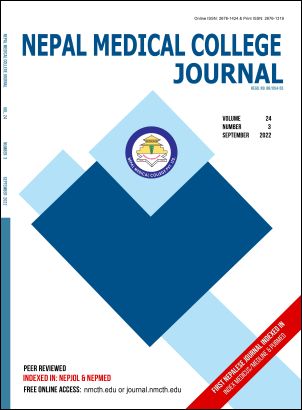Assessment of Alveolar Bone Height and Width in Maxillary Anterior teeth - A Radiographic Study Using Cone Beam Computed Tomography
DOI:
https://doi.org/10.3126/nmcj.v24i3.48596Keywords:
Cone beam computed tomography, extraction, implant, maxillaAbstract
Cone beam computed tomography (CBCT) can be used for determining the height and width of alveolar bone surrounding the implant site which are important factors in implant planning. This study was done to evaluate and compare alveolar bone height and width in maxillary anterior teeth based on CBCT images from Nepalese population. This retrospective study included patients who had done CBCT scan between January 2019 to December 2020. Sagittal section views perpendicular to alveolar ridge were taken in the middle of maxillary left and right central incisor, lateral incisor, and canine regions and the linear measurements were done to measure alveolar height (between floor of nasal fossa and alveolar crest) and width (between buccal and palatal cortical plate). The result revealed no significant difference in alveolar height among maxillary anterior teeth. Mean alveolar width for maxillary right central incisor (11), lateral incisor (12), and canine (13) were 12.09 ± 2.36, 8.27 ± 1.37 and 9.99 ± 1.44 mm, respectively and for maxillary left central incisor (21), lateral incisor (22), and canine (23) were 9.51 ± 1.47, 8.27 ± 1.32 and 10.35 ± 1.85 mm, respectively. Lateral incisors have less width as compared to other maxillary anterior teeth. Pearson’s correlation analysis for correlating alveolar height with width showed p<0.05 among 13, 12, 21 and 22. There is weaker correlation between the mean of alveolar height and width. The alveolar height as well as width was greater in male than female in all the six anterior teeth except for the alveolar width in relation to 11.
Downloads
Downloads
Published
How to Cite
Issue
Section
License
Copyright (c) 2022 Nepal Medical College Journal

This work is licensed under a Creative Commons Attribution 4.0 International License.
This license enables reusers to distribute, remix, adapt, and build upon the material in any medium or format, so long as attribution is given to the creator. The license allows for commercial use.




